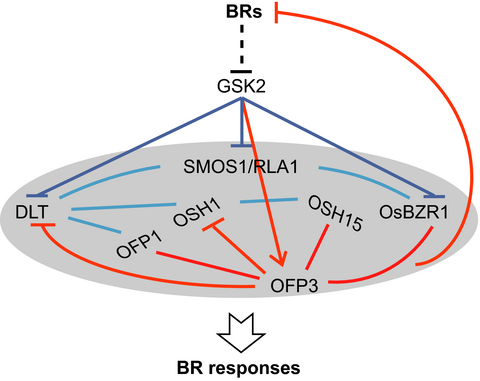Our official English website, www.x-mol.net, welcomes your feedback! (Note: you will need to create a separate account there.)
GSK2 stabilizes OFP3 to suppress brassinosteroid responses in rice.
The Plant Journal ( IF 7.2 ) Pub Date : 2020-01-17 , DOI: 10.1111/tpj.14692 Yunhua Xiao 1 , Guoxia Zhang 1, 2 , Dapu Liu 1, 2 , Mei Niu 3 , Hongning Tong 3 , Chengcai Chu 1, 2
The Plant Journal ( IF 7.2 ) Pub Date : 2020-01-17 , DOI: 10.1111/tpj.14692 Yunhua Xiao 1 , Guoxia Zhang 1, 2 , Dapu Liu 1, 2 , Mei Niu 3 , Hongning Tong 3 , Chengcai Chu 1, 2
Affiliation

|
Brassinosteroids (BRs) are a class of phytohormones that modulate several important agronomic traits in rice (Oryza sativa ). GSK2 is one of the critical suppressors of BR signalling and targets transcription factors such as OsBZR1 and DLT to regulate BR responses. Here, we identified OFP3 (OVATE FAMILY PROTEIN 3) as an interactor of both GSK2 and DLT by yeast‐two‐hybrid screening and demonstrated that OFP3 plays a distinctly negative role in BR responses. While knockout of OFP3 promoted rice seedling growth, overexpression of OFP3 led to strong BR insensitivity, which resulted in reduced plant height, leaf angle, and grain size. Interestingly, both BR biosynthetic and signalling genes had decreased expression in the overexpression plants. OFP3 overexpression also enhanced the phenotypes of BR‐deficient mutants, but largely suppressed those of BR‐enhanced plants. Moreover, treatment with either BR or bikinin, a GSK3‐like kinase inhibitor, induced OFP3 depletion, whereas GSK2 or brassinazole, a BR synthesis inhibitor, promoted OFP3 accumulation. Furthermore, OFP3 exhibited transcription repressor activity and was able to interact with itself as well as additional BR‐related components, including OFP1, OSH1, OSH15, OsBZR1, and GF14c. Importantly, GSK2 can phosphorylate OFP3 and enhance these interactions. We propose that OFP3, as a suppressor of both BR synthesis and signalling but stabilized by GSK2, incorporates into a transcription factor complex to facilitate BR signalling control, which is critical for the proper development of various tissues.
中文翻译:

GSK2可稳定OFP3,从而抑制水稻中的油菜素类固醇反应。
油菜素类固醇(BRs)是一类植物激素,可调节水稻(Oryza sativa)中的几种重要农艺性状。GSK2是BR信号传导的关键抑制剂之一,并靶向OsBZR1和DLT等转录因子来调节BR反应。在这里,我们通过酵母双杂交筛选确定了OFP3(卵清蛋白3)是GSK2和DLT的相互作用因子,并证明OFP3在BR反应中起明显的负作用。虽然敲除OFP3可以促进水稻幼苗的生长,但是OFP3的过表达导致强烈的BR不敏感性,导致植株高度,叶片角度和籽粒大小的降低。有趣的是,BR生物合成和信号转导基因在过表达植物中均降低了表达。OFP3的过表达也增强了BR缺陷型突变体的表型,但在很大程度上抑制了BR增强型植物的表型。此外,用BR或GSK3样激酶抑制剂比基尼素治疗会导致OFP3耗竭,而用BR合成抑制剂GSK2或Braskinazole会促进OFP3的积累。此外,OFP3表现出转录阻遏物活性,并且能够与自身以及其他BR相关成分(包括OFP1,OSH1,OSH15,OsBZR1和GF14c)相互作用。重要的是,GSK2可以磷酸化OFP3并增强这些相互作用。我们提议,OFP3作为BR合成和信号转导的抑制剂,但被GSK2稳定,并入转录因子复合物中以促进BR信号转导控制,这对于各种组织的正常发育至关重要。
更新日期:2020-01-17
中文翻译:

GSK2可稳定OFP3,从而抑制水稻中的油菜素类固醇反应。
油菜素类固醇(BRs)是一类植物激素,可调节水稻(Oryza sativa)中的几种重要农艺性状。GSK2是BR信号传导的关键抑制剂之一,并靶向OsBZR1和DLT等转录因子来调节BR反应。在这里,我们通过酵母双杂交筛选确定了OFP3(卵清蛋白3)是GSK2和DLT的相互作用因子,并证明OFP3在BR反应中起明显的负作用。虽然敲除OFP3可以促进水稻幼苗的生长,但是OFP3的过表达导致强烈的BR不敏感性,导致植株高度,叶片角度和籽粒大小的降低。有趣的是,BR生物合成和信号转导基因在过表达植物中均降低了表达。OFP3的过表达也增强了BR缺陷型突变体的表型,但在很大程度上抑制了BR增强型植物的表型。此外,用BR或GSK3样激酶抑制剂比基尼素治疗会导致OFP3耗竭,而用BR合成抑制剂GSK2或Braskinazole会促进OFP3的积累。此外,OFP3表现出转录阻遏物活性,并且能够与自身以及其他BR相关成分(包括OFP1,OSH1,OSH15,OsBZR1和GF14c)相互作用。重要的是,GSK2可以磷酸化OFP3并增强这些相互作用。我们提议,OFP3作为BR合成和信号转导的抑制剂,但被GSK2稳定,并入转录因子复合物中以促进BR信号转导控制,这对于各种组织的正常发育至关重要。



























 京公网安备 11010802027423号
京公网安备 11010802027423号